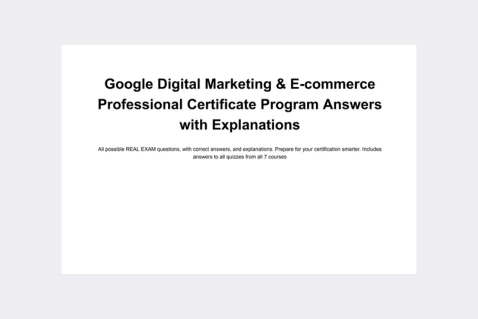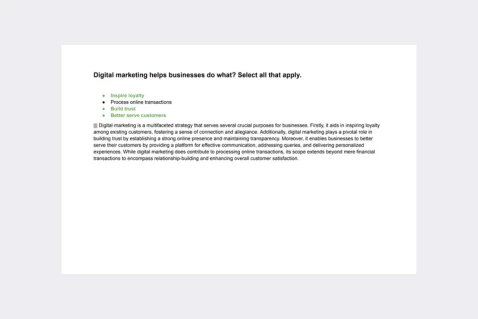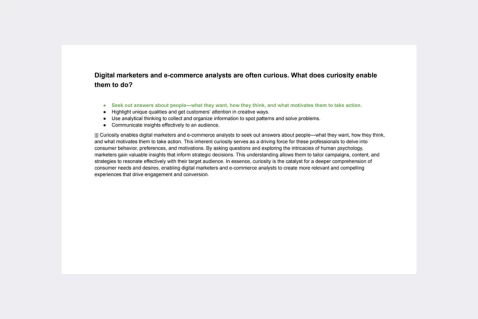As a digital marketer, you may create ads. Which of the following refers to responsive display ads?
You have total control and are required to generate ad combinations for website and apps
You have less control over the ad’s appearance, but it is easier than creating the ad yourself
You require all design resources and the time to create the ad according to a specific format
You use Google to upload the content, such as images, headlines, logos, videos, and descriptions
Certification program: 👉 Google Digital Marketing & E-commerce Professional Certificate (Coursera)
Explanation: Responsive display ads provide digital marketers with the advantage of having less control over the ad’s appearance, but they are easier to create compared to designing the ad manually. In responsive display ads, advertisers provide various creative assets such as images, headlines, logos, videos, and descriptions to Google. The system then automatically generates ad combinations that are dynamically adapted to fit different ad spaces across the Google Display Network. This format is particularly beneficial for advertisers who may not have the time or resources to create multiple ad variations manually. Responsive display ads optimize for performance by adjusting their appearance based on the available space and the preferences of potential customers, ultimately enhancing the effectiveness of the advertising campaign.
Passing exams is not a workout. Multiple attempts won’t make you stronger.



- All possible certificate program questions
- Real certification exam questions
- Detailed answer explanations.
- Over 1700 questions, 7 courses, 30 quizzes
- Free lifetime updates.
Unleashing the Power of Responsive Display Ads in Digital Marketing
In the ever-evolving landscape of digital marketing, creating compelling ads that resonate with your target audience is essential for driving engagement and achieving campaign objectives. One innovative ad format that has gained popularity among digital marketers is responsive display ads. But what exactly are responsive display ads, and how can they benefit your marketing efforts? Let’s explore.
Understanding Responsive Display Ads
Responsive display ads are a dynamic ad format that automatically adjusts its size, appearance, and format to fit the available ad space across various websites and devices. Unlike traditional static ads, responsive display ads adapt to the layout and design of the publisher’s website, ensuring a seamless and visually appealing experience for users.
Key Features of Responsive Display Ads
Responsive display ads offer several key features that make them a valuable asset in any digital marketer’s toolbox:
-
Flexibility: Responsive display ads adapt to different ad placements and device types, including desktops, tablets, and smartphones. This flexibility ensures that your ads are optimized for maximum visibility and engagement across various platforms.
-
Dynamic Creatives: Responsive display ads can include a combination of text, images, and videos, allowing for dynamic and visually appealing ad experiences. Marketers can upload multiple images, headlines, descriptions, and logos, and Google’s machine learning algorithms will automatically test different combinations to determine the most effective variations.
-
Performance Insights: Responsive display ads provide valuable performance insights and optimization recommendations through Google Ads. Marketers can monitor key metrics such as impressions, clicks, conversions, and click-through rates to assess the effectiveness of their ads and make data-driven decisions to improve performance.
Practical Insights for Using Responsive Display Ads
To leverage responsive display ads effectively in your digital marketing campaigns, consider the following practical insights:
-
Utilize High-Quality Visuals: Use high-quality images and videos that capture the attention of your target audience and communicate your brand message effectively. Avoid cluttered or low-resolution visuals that may detract from the user experience.
-
Craft Compelling Copy: Write concise and compelling headlines and descriptions that highlight the unique value propositions of your products or services. Experiment with different messaging strategies to see which resonates most with your audience.
-
Test Different Variations: Take advantage of Google’s machine learning capabilities to test different combinations of images, headlines, and descriptions. Continuously monitor performance and make adjustments based on data insights to optimize your ads for maximum effectiveness.
-
Optimize for Mobile: With an increasing number of users accessing the internet on mobile devices, ensure that your responsive display ads are optimized for mobile viewing. Test your ads on different screen sizes and devices to ensure a seamless and engaging experience for mobile users.
-
Stay Creative and Innovative: Don’t be afraid to think outside the box and experiment with new ideas and formats. Keep abreast of industry trends and best practices to stay ahead of the competition and capture the attention of your target audience.
Embracing the Power of Responsive Display Ads
In conclusion, responsive display ads offer digital marketers a powerful and versatile tool for creating engaging and visually appealing advertising experiences. By leveraging the flexibility, dynamic creatives, and performance insights of responsive display ads, marketers can drive engagement, increase brand awareness, and ultimately, achieve their campaign objectives.
Remember, in the fast-paced world of digital marketing, staying ahead of the curve is key to success. So, embrace the power of responsive display ads and unleash their full potential in your marketing campaigns.
Discover our best-value guides
- Special Bundle Offer Google_Ads_Roll
- Special Bundle Offer HubSpot_Exams_Roll
- Special Offer Unchained_Guru_Roll
- Special Bundle Offer Amazon_Roll
- Special Bundle Offer Google_Analytics_Roll
- Special Bundle Offer Google_SkillShop_Roll
- Special Bundle Offer Marketing_Platforms_Roll
- Special Bundle Offer Microsoft_Advertising_Roll
- Special Bundle Offer YouTube_Roll
- Special Bundle Offer Google_Android_Roll
- Ultimate PMP certification preperation guide
- Google Cloud Professional Architect Certification Exam Answers - Ultimate Guide
- Special Bundle Offer SEMrush_Roll